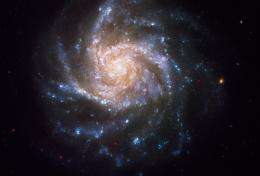Snowflake-Shaped Galaxy From Hubble Helps Ring in the New Year

(PhysOrg.com) -- As part of its Hubble Heritage program, NASA has released an image, taken by a team led by UA astronomer Rodger Thompson, of a galaxy that resembles a snowflake.
A bluish-white spiral galaxy hangs delicately in the cold vacuum of space. Like snowflakes, no two galaxies are exactly alike. Known as NGC 1376, this snowflake-shaped beauty has features that make it a one of a kind. Bright blue knots of glowing gas highlight regions of active star formation.
Concentrated along the spiral arms, these areas of star formation show an excess of light at ultraviolet wavelengths for they contain brilliant clusters of hot, newborn stars that are emitting UV light. The less intense, red areas near the core and between the arms consist mainly of older stars. The reddish dust lanes are colder, denser regions where interstellar clouds may collapse to form new stars. Intermingled between the spiral arms are a sprinkling of reddish background galaxies.
NGC 1376 resides more than 180 million light-years away from Earth in the constellation Eridanus. This galaxy belongs to a class of spirals that are seen nearly face on from our line of sight. This orientation aids astronomers in studying details and features of the galaxy from an unobscured vantage point. One such feature of galaxies are stars that change in brightness over time. In 1990, NGC 1376 was home to a supernova (SN 1990go) explosion that rivaled the brightness of the entire nucleus from ground-based telescopes for several weeks.
How this galaxy came to be photographed by Hubble is quite unique in itself. During observations of a nearby dwarf galaxy in November 2006 with Hubble's Near Infrared Camera and Multi-Object Spectrometer, known as NICMOS, careful planning allowed NGC 1376 to be visible in the field of view of the Advanced Camera for Surveys, or ACS, at the same time.
Thus, Hubble was able to get two galaxies for the price of one. Initial ground-based observations of the two galaxies implied that the two might be interacting with each other, but the Hubble observations concluded that there were no obvious signs of interaction. NGC 1376 was imaged with ACS in eight filters ranging from blue to visible to infrared light. Four of the images that show the most color separation were used in this Hubble composite of NGC 1376.
Provided by University of Arizona




















